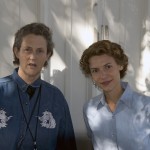International Autism Awareness Day is on Friday, April 2nd and what better way to celebrate than by watching an HBO documentary about a family from Iceland that travels to the United Kingdom, Denmark, and many different states in the US to find ways to help their child with autism?
Producer Margret Dagmar Ericsdottir decided to film her search to find help for her son, Keli, who is ten years old and severely effected by autism. Directed by Fridrik Thor Fridksson (the Oscar nominee Children of Nature), and narrated by Oscar winner Kate Winslet, the film takes us to different places where Margret interviews parents, advocates, scientists and professionals. Temple Grandin, Ph.D., whose life story recently aired on HBO, provides insight, as does Dr. Geraldine Dawson, chief science officer of Autism Speaks. Dr. Simon Baron-Cohen director of the Autism Research Centre at the University of Cambridge, and Dr. David G. Amaral, research director, Mind Institute also provide food for thought.
This documentary does not sugarcoat autism, or celebrate it, or cure it. The movie’s strength lies in that it shows the heart-wrenching reality of what families have to go through to get assessments, diagnosis and advice; it shows the reality of the pain parents feel when their bubbly, verbal child regresses and becomes autistic. We visit with families who have more than one child with autism. A Mother’s Courage does not try to cover all the autism treatments and therapies (i.e., biomedical interventions); it would take a series to do that, not just one film. Instead, the last half part of the film focuses on what Margret has found that works with her child, the Rapid Prompting Method (RPM).
This HBO film is a good resource for promoting community awareness that families can share with their relatives and neighbors. They will gain a better understanding of what families effected by autism go through every day (the motivation behind my writing the recently published book, 41 Things to Know About Autism).
A Mother’s Courage shows us how caring and concerned professionals are; they don’t have all the answers though they wished they did. Joseph E. Morrow, Ph.D., BCBA
and Brenda J. Terzich-Garland, M.A., BCBA founders of Applied Behavior Consultants (ABC ) in Sacramento say that 40 % of the children who attend ABC school at an early age (where they receive intensive therapy based on the principles of applied behavior analysis, ABA) are able to be integrated in their neighborhood school after two years. We are left thinking, but what about the other kids — the kids that make some progress with ABA but never learn to communicate past the “I want” step with the Picture Exchange Communication System (PECS) or never get past three-word sentences?
In the film, we find out that luckily, Portia Iverson and Jonathan Shestack, co-founders of Cure Autism Now, wondered the same thing, and brought Soma Mukhopadhyay to the United States after hearing about how Soma had developed a method to teach her son, Tito.
Margret visits Soma, now the Educational Director of HALO (Helping Autism Through Learning and Outreach) based in Austin, and meets Linda Lange, founder of HALO and other parents and their children. For parents of children with autism who are not familiar with the Rapid Prompting Method, this is the part of the movie that will enlighten them to another possible method for teaching academics and communication. RPM is not a miracle cure, it’s a way to try and reach children using the learning modality that works best for them. The footage of Soma working with Keli gives a good overview of RPM.
My son Jeremy was taught by Soma for a year and a half on a bi-monthly basis when she lived in California. Recently Jeremy wrote an article on How The Rapid Prompting Method Gave Me A Voice. After watching A Mother’s Courage he spelled,
“I am really glad to see people talking about people like me. The fact is, there are many of us. I think there needs to be more understanding. I get frustrated by people not realizing I am smart. But I know I am one of the lucky ones because my mom found a way for me to learn and communicate and the school continued.”
I wish there would have been a better choice made for the final scenes of the movie. Whereas Soma is down to earth and logical, the music took on heavenly tones and rose to a crescendo with angels singing in the background. The symbolic last scene of mother and son walking though a fog with the sun and heavenly music breaking through was heavy-handed.
Much better to have ended on Soma’s words — realistic and inspirational in a practical manner:
“What we have to do now is to educate him so he becomes aware of what he is capable of and lives according to his capability.”
Isn’t that what all parents strive for and want for their children?
 Lars Perner, Ph.D., Chair, Panel of People on the Spectrum of Autism Advisors for the Autism Society of America, and Assistant Professor of Clinical Marketing, USC, had this to say about A Full Life with Autism:
Lars Perner, Ph.D., Chair, Panel of People on the Spectrum of Autism Advisors for the Autism Society of America, and Assistant Professor of Clinical Marketing, USC, had this to say about A Full Life with Autism:





